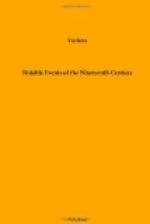These facts tend to show that every world has in its career an intermediate period which may be called the epoch of life. Before the epoch of life begins there is in the given world no such form of existence. There is matter only. Then at a certain stage the epoch of life begins. The epoch of life continues for a vast indeterminate period. No doubt in some of the worlds an epoch of life has been provided ten times as great, possibly a thousand times as great, as in other planets. After the epoch of life begins only certain forms of existence are for a while possible. Then other and higher forms succeed them, and then still higher. Thus the process continues until the highest—that is, the conscious and moral form of existence becomes possible, and that highest, that conscious, that moral form of being is ourselves.
This is not all. The epoch of life seems to be terminable at the further extreme by a planetary condition in which life is no longer possible. The New Astronomy indicates the coming of a condition in all the worlds when life must disappear therefrom and be succeeded by a lifeless state of worldhood. This may be called the epoch of death—that is, of world-death. It seems to be almost established by investigation and right reason that worlds die. They reach a stage in which they are lifeless. They cool down until the waters and gases that are on the surface and above the surface recede more and more into the surface and then into the interior, until they wholly disappear. Cold takes the throne of nature. Universal aridity supervenes, and all forms of vegetable and animate existence go away to return no more. They dwindle and expire. The conditions that have come are virtually conditions of death.
Whether the universe contains within itself, under the Almighty supervision, certain arrangements and laws by which the dead world can be again cast into the crucible and regenerated by liberation through the action of heat into its primordial state once more and go the same tremendous round of planet life, we know not. The conception of such a process, even the dream or vague possibility of it, is sufficiently sublime and fills the mind with a great delight in contemplating the possible cycles through which the material universe is passing.
At any rate, we may contemplate the three great stages of world-life with which we are already acquainted—that is, the birth stage, the epoch of life and the epoch of death. There is a birth, as also a life and a death of planets. Richard A. Proctor, of great fame, on one of his last tours of instructive lecturing among our people, had for his subject the “Birth and Death of Worlds.” The theme was not dissimilar to that which has been here presented in outline. The birth, the life and the death of worlds! Such is a summary of that almost infinite history through which our earth is passing—the history which the globe is making on its way from its nebulous to its final state.




